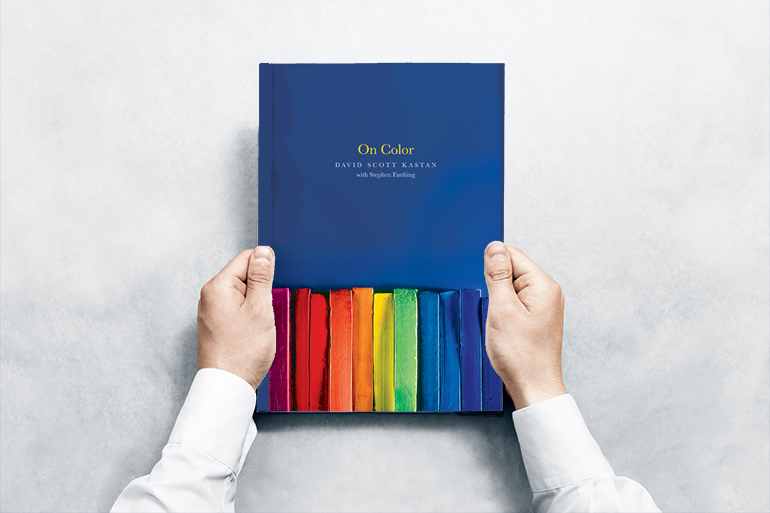Book Review: 'On Color' by David Scott Kastan

How often does the average person interact with color? Every waking second. And how often does the average person think about color? Not often. But after reading David Scott Kastan’s new book On Color (Yale University Press, $28)—his collaboration with longtime artist friend Stephen Farthing—color might become an everyday part of a reader’s thought process. After all, the nonfiction book, which strives to examine color as a concept from every angle, sheds innovative insight on something omnipresent—something abstract yet concrete—that we intermingle with on the daily whether we’re brainstorming color schemes for a home renovation, contemplating the different shades of the ocean and the sky at the beach, or gazing into our glass of rosé.
“Color, it turns out, is something shared, and also something impossible to share, or maybe just impossible to know if or how it is shared,” Kastan, an Amagansett resident, writes in the book’s preface. The decision to delve into the intricacies of color—the anthropology of it, the historical contexts, the literary, philosophical, political, scientific, and the cultural contexts of it—is a cosmically large one. It’s a massive undertaking, but one that Kastan tackles with masterful ease, the mark of a writer genuinely fascinated and infatuated with his own book’s subject.
He continues, seemingly addressing what a huge undertaking the exploration of color is, justifying his and Farthing’s choice to dive deep into something so abstract. “But color is also unavoidable and irresistible—and always worth the effort of trying to understand its many wonders,” Kastan writes. This is a big idea, an important sentiment that’s not only true, but also eloquently and concisely put. How do we manage something as conceptual and behemoth as color? How do we fit it into a little box, a little book of 213 pages and several photos and illustrations? We do it, according to Kastan and Farthing, color by color.
Through 10 chapters—consecutively labeled Roses Are Red, Orange Is the New Brown, Yellow Perils, Mixed Greens, Moody Blues, Dy(e)ing for Indigo, At the Violet Hour, Basic Black, White Lies, and Gray Areas—Kastan and Farthing take readers on a journey through the significance of our world’s hues. The duo establishes quickly that it’s more than “the grass is green” and “the sky is blue.” Kastan demonstrates the weight of color through beautiful, persuasive prose while weaving through multifarious concepts: “Color marks our emotional and social existence. Our psychological states have color: we see red, feel blue, are tickled pink, and not infrequently, are green with envy, particularly when confronted by those so tickled.” The concept may be high-brow, but the writing is not.
Each chapter is punctuated by vibrant photographs and illustrations that serve to show rather than tell. A picture is worth a thousand words, as the old adage goes. With the combination of Kastan’s words and Farthing’s pictures, the story of color resonates deeper. Each illustration backs up Kastan’s words simply by existing. For example, Kastan dives deeply into the etymology of the word orange: “Orange, however, seems to be the only basic color word for which no other word exists in English. There is only orange, and the name comes from the fruit… But there was no orange, at least before oranges came to Europe. This is not to say that no one recognized the color, only that there was no specific name for it.” A blown-up image of a ripe orange, contrasted against an all-black background, is nestled on the opposite page. As Kastan works to unravel the etymology of “orange” by careening backward through history, the images work to simply scream what we already know when we look at it: ORANGE. THIS IS ORANGE.
On Color is a profound nonfiction exploration of the various ways color influences our daily lives, both on a personal and larger scale. By examining the politics, culture and historical implications of each of these 10 colors, Kastan and Farthing tickle the surface of a conversation that’s begging to be had—especially in today’s current political and social economic climate. Kastan, a professor of English at Yale and author of several other publications including Shakespeare and the Shapes of Time, Shakespeare After Theory and A Will to Believe: Shakespeare and Religion, has a way of taking sizeable concepts and fitting them into digestible, well-written sentences that make the reader go, “Oh, this makes sense. Why didn’t I think of this?” It’s that kind of to-the-point, smart and concise writing that will keep On Color on the shelves of Hamptons readers for years to come.
Speaking of readers: Who will enjoy On Color? Deep thinkers who revel in an artist’s ability to take the conceptual, the too-big-to-stuff-into-a-box, and do just that: examine it closely (and wisely and elegantly), in just more than 200 pages, and decode it. You don’t have to be a doctorate-level sophisticate with myriad accolades to enjoy On Color—but you may feel like you’re one after finishing the book.
On Color is available now at your local bookstore.



